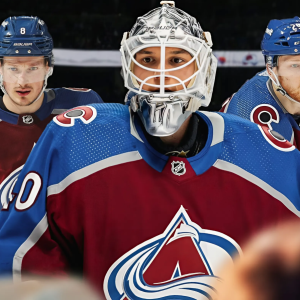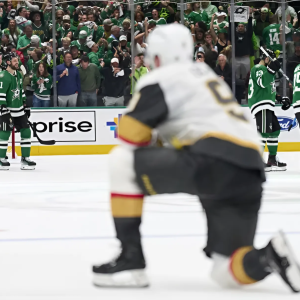The single most defining trait of Steve Yzerman’s tenure as Red Wings GM has been his patience. Frustrating at times, Yzerman’s calm approach hasn’t wavered even when his team has sniffed playoff contention. A lack of aggressive trades or free agent signings has drawn the ire of those desperate for him to make Detroit a playoff contender after a long rebuild. Some ask how long Yzerman will continue to tread water, avoiding the kind of moves of a team trying to win now.

How about 2026?
The 2026 offseason projects to see a paradigm shift for the Red Wings’ approach. In that offseason, Yzerman has set himself up with a blank canvas on his cap sheet with a number of prospects ready to join the fold as NHLers. The table is set for this offseason to be the one where Detroit can swing for the fences, where the rebuild shifts into the contention window.
The biggest reason 2026 is the turning point is sheer cap flexibility. Just five current forwards — Larkin, DeBrincat, Copp, Compher and Rasmussen — will still be under contract by then, while RFA Lucas Raymond is likely to join them with his upcoming extension. On the blue line, the only defensemen under contract will be Moritz Seider on his upcoming extension and Simon Edvinsson as an RFA that offseason. In net, Yzerman doesn’t have a single contract extending past 2026.
Such a clear cutoff date for so many contracts might point to instability in the long term. Having a cohort of just six to eight players under contract for more than two seasons shows a lack of longevity for the current roster, a sign of immense change to come. But that’s all fine and well for Detroit, because the current roster isn’t one it’s planning to rely on down the road. The open contract situations of 2026 lend themselves to the construction of a more long term roster, where the Red Wings can pick and choose who they want to keep around to surround the arrival of some high-upside prospects to the NHL fold.
The maturation of prospects by 2026 projects to fill a lot of the open roster slots, if all goes according to plan. By leaving so many spots open, Yzerman has left paths for prospects like Jonatan Berggren, Marco Kasper and Carter Mazur to become contributors and earn their place by unseating established veterans. The Red Wings should also get more recent picks like Nate Danielson, Axel Sandin Pellikka and Michael Brandsegg-Nygard into the lineup by 2026, too, again bringing them along on their own timeline by forcing players to beat out established vets. In net, goaltender Sebastian Cossa should be in position to play NHL games by then, and the lack of goalies under contract allows Yzerman to decide whether to make him the starter or bring in some help.
Whether it happens as late as 2026 or earlier, the hardening of this prospect foundation is one of the most important moves for the Red Wings to make. This is the group that will lead Detroit in the long run, the rationale behind Detroit’s M.O. of picking solid 200-foot players in the draft instead of chasing star power.
“We’re trying to build a core that’s going to be together for a number of years, and unfortunately it takes time,” Yzerman said July 4. “And depending on how your drafts go — where you draft, who’s available in those drafts — it can expedite the process, or it can be slower. And I’m going to continue to try to be patient with our draft choices or prospects until they’re ready to go and we’ll keep building on that group. … We all would love to make the playoffs next year, we would have loved to have made the playoffs last year, but ultimately we’re still trying to put together that core of young guys that is going to be together and start to creep into the playoffs and hang around the playoffs and maybe eventually win.”
By 2026, the core should be in the lineup. Meanwhile, the contracts currently in place are the sorts of leaders and accent pieces that will make that roster more competitive. With Larkin, Detroit has its captain and heartbeat. With DeBrincat, it has a sniper that linemates can feed. And with Copp, Compher and Rasmussen, it has a reliable checking presence that can maintain defensive integrity amid a youth movement. The players still under contract in 2026 are the kind that are useful on any roster, not just free agents who were upgrades from Detroit’s basement days.
If Detroit needs to sign any upgrades, it will have plenty of leash to make moves. The NHL salary cap is projected to eclipse $92 million by 2026, and the Red Wings will only have around $30 million on the books plus whatever Raymond and Seider make. Barring any free agent splashes in 2025 or a big sign-and-trade, Detroit stands to have nearly half its cap space at its disposal to flesh out the rest of the roster. That’s enough for the Red Wings to get splashy in the way many have been waiting to see.
This flexibility might explain why Yzerman played free agency relatively cool this offseason, avoiding the free agent class’s crown jewels and focusing on a few depth additions on short-term deals. Yzerman avoided the extensive contract term that many players received this offseason, keeping his 2026 cap sheet clean.
“The big fish, whatever you want to call them, … nothing was really shocking there or unexpected there,” Yzerman said July 4. “What was a little bit more interesting was the term and the dollars a lot of role players got. I didn’t really see that. It wasn’t really our model. There’s a lot of players around the league that were free agents that we really think would be a good fit for us, we’d really like to get them. Not so much the dollars but the term was attention grabbing.”
Such a long term commitment for role players was out of the question, explaining why Detroit’s longest free agency deals were the two-year variety. His moves maintain 2026 and beyond as a new era. And while some contracts might seem like a bit of an overpay, by avoiding term past 2026, Yzerman pays a premium to give himself the greatest ability to build a well-timed contender.
2026 is the nexus of salary cap maintenance and prospect development, when all the pieces that Detroit has been waiting for should arrive. It’s the offseason that the Red Wings should finally be in position to make big moves.
To be clear, the Red Wings aren’t just waiting for their calendars to flip to 2026. They’re still trying to make the playoffs, building a roster to hover around wild card contention just like last season. But making the playoffs now is a secondary goal to really contending in the future. Detroit isn’t going to move assets to make its current roster more competitive when it can work to make teams in 2026 and beyond true contenders.
Even if 2026 is shaping up to be a big offseason for Detroit, the question remains whether Yzerman could have advanced this date with more aggressive moves. By 2026, it will be a whopping seven years after Yzerman took the reins as GM and a whole decade since Detroit made the playoffs. The biggest hurdle for speeding up the timeline would be prospect development, a process that is anything but linear and so hard to quicken. Anyone depending on prospects has to bear patience, even when it’s frustrating like the Red Wings’ slow climb has been.
The projected ascent in 2026 might make it all worth it, when the Red Wings will truly be in position to go for broke and contend. Until then, don’t expect Detroit to pick up the pace.





